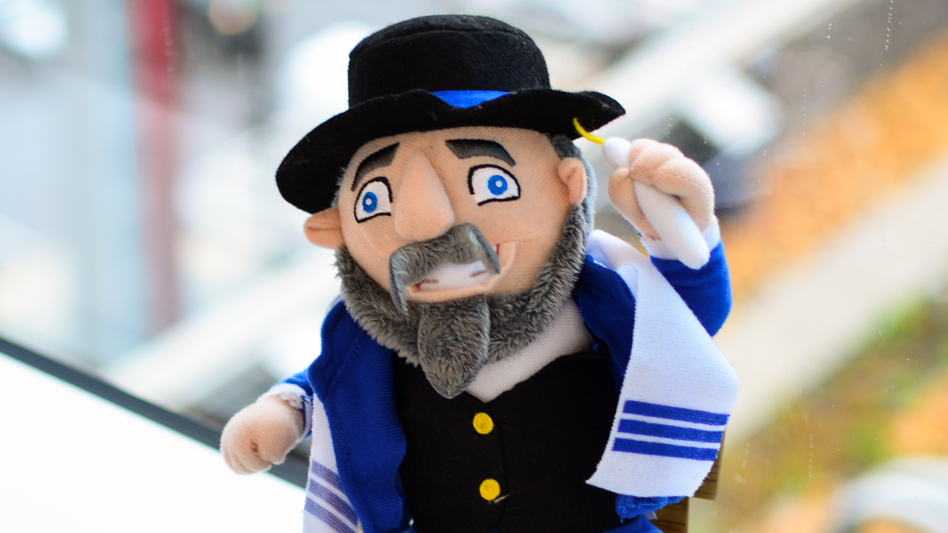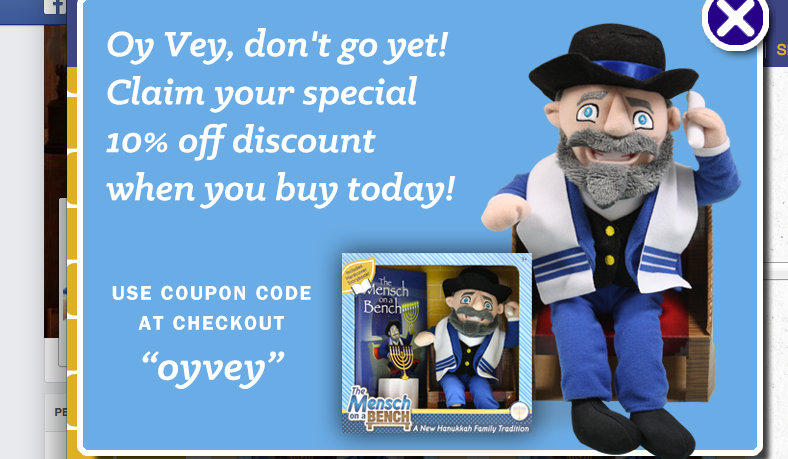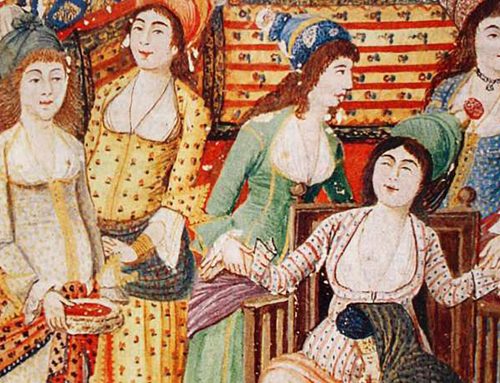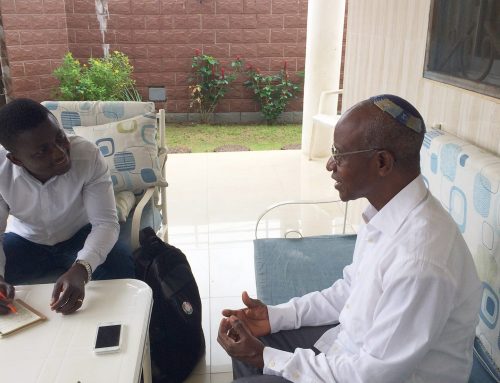
This year’s Hanukkah toy sensation, The Mensch on a Bench, brings shtetl nostalgia into the Hanukkah story.
When Judah Met Moshe
The Hanukkah toy sensation, The Mensch on a Bench, started out last year as an explicit homage to the popular Christmas toy, The Elf on the Shelf. According to that toy’s lore, every scout elf adopted by a family can fly back and forth between the family’s home and Santa’s workshop at the North Pole. Neal Hoffman, who used to work for the toy company Hasbro, wanted to give his son a similar, but Jewishly-appropriate, holiday visitor.
And a mensch was born.
Hoffman named his creation—what else?—Moshe. Like his elfin model, Moshe has a backstory and a higher purpose during the holiday season. The Moshe mythos (available in handy book form) places black-hatted, tallit-wearing Moshe at the heart of the ancient Judean action after Judah and the victorious Maccabees have returned to the Temple. Seeing how tired they are, Moshe offers to sit on his bench and watch over the oil while the warriors sleep.
By inserting his frum-looking Moshe into the middle of the Maccabees’ swords-and-sandals epic, Hoffman has, perhaps unknowingly, created a human embodiment of the shamash—the “servant” candle that lights and guards the others. With his undeniably Orthodox attire and cozy beard, Moshe strikes me as an Eastern European delegate from the Diaspora shtetl future, transported to the holy land past to help make the Hanukkah miracle happen.
His superpower? The ability to sit for really long periods of time. Take that, the Hebrew Hammer!
Shtetl Culture as a Marketing Tactic
Hoffman’s kid-friendly midrash on the Hanukkah story might not fly with purists of the pseudepigrapha, but it has spelt gelt for the timely toy inventor. Riding the tide of a successful Kickstarter campaign, Hoffman has parlayed public demand for his Mensches on Benches into a flourishing business that promises to “Add more FUNUKKAH to your HANUKKAH!” The toy is inherently social media-friendly and selfie-ready, as evidenced by the Mensch’s 10,000-plus likes on Facebook.
The nostalgic trappings of Yiddish and shtetl culture are clearly a part of Hoffman’s marketing aesthetic. As I explore the Mensch on a Bench website and click away from the purchasing page, a popup window implores me with the classic Yiddish cry of anguish: “Oy Vey, don’t go yet!” and offers me a 10% discount code (“oyvey”). Hoffman’s Moshe, if he doesn’t speak straight Yiddish, likely does speak Yeshivish.
And the very name of the toy utilizes perhaps the central moral concept in Yiddish vocabulary: menschlichkeit, or humanity. Which led me to the question, How menschy is the Mensch on a Bench, anyway?
The Moral Meaning of Menschiness
As the Forward’s Philologos pointed out in a 2010 column, German does not layer on this secondary meaning: “To be a Mensch in German is to be an ordinary person rather than an exceptional one.” In the Yiddish cultural universe, however, being a person is inherently wrapped up with being a good person; human existence comes with a clear ethical obligation to other people. The imperative expression, “Zay a mensch!” (“Be a good person!”), was the 11th commandment for Jews trying to make their way in the modern world.
A perfect summary of this moral worldview can be found in Joseph C. Landis’ chapter on Yiddish in Understanding Jewish Theology: Classical Issues and Modern Perspectives. Landis calls Yiddish “the translation into language of the ethic of Ashkenazi Jews” and explains that ethic as mentsh-centric: “Dedicated as it thus was to the values of the head and the heart, to Torah and maysim tovim [/fusion_builder_column]
In calling his Hanukkah must-have toy The Mensch on a Bench, it seems Neal Hoffman has dipped his toe into somewhat deep psycho-religious territory. Does Moshe the Mensch hold up to this centuries-old Jewish standard of upstanding behavior?

The discount code for The Mensch on a Bench? Oyvey, of course.
The Mensch Rules and Eight Silly Selfies
Moshe’s purpose in Hoffman’s revamped Hanukkah tale is undeniably menschy, too: assessing the post-battle situation at the Temple, Moshe acts upon his inner ethical urge to be responsible for the welfare of others. As a result, menschlichkeit takes center stage in a narrative that, to this point, has revolved around the optics of armed rebellion. It takes some chutzpah to retrofit the Maccabees’ story with the Ashkenazic moral worldview, to insist that the modern mensch’s particularly Jewish humanism has a rightful place in ancient times, too.
Is Moshe the Mensch’s shtetl shtick a canny marketing ploy, an earnest attempt to teach kids about Jewish values, or a little of both? Regardless, it’s hard to argue with a toy that is encouraging children to engage with the story of Hanukkah, to share their excitement with others, and to learn a bisl (tiny bit of) Yiddish along the way. If that excitement comes cloaked in a “limited-edition” blue tallit for sale on Zulily, so be it. I’m already getting ready to scoop up next Hanukkah’s toy sensation: The Maidel with a Dreidel.
Links for Further Exploration
- “Totes Koshe” T-Shirts and the Rise of Cheeky Yiddish Leisurewear by Hannah Pressman (Oct. 2015)
- Saying Shana Tova with a Yiddish Postcard by Hannah Pressman (Sep. 2014)







This is one of the most thoughtful articles I have read. Well done!
If you would like to do a follow up interview and discuss some of the questions you have, I would love to! Reach out anytime!
P.S. If you dont have a Mensch, I can get you one!